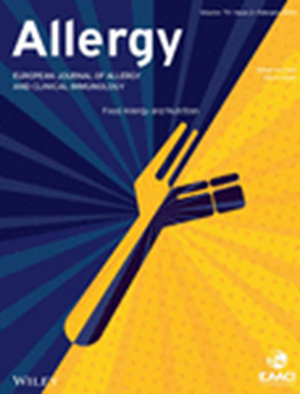Impact of Residential Greeness Exposure on the Development of Allergic Diseases and Asthma and on Asthma Control—A Systematic Review for the EAACI Guidelines of Environmental Science for Allergic Diseases and Asthma
IF 12.6
1区 医学
Q1 ALLERGY
引用次数: 0
Abstract
The role of residential greenness exposure (RGE) in prevention and control of allergic diseases remains controversial. This systematic review evaluated the association between RGE and the risk of developing asthma, allergic rhinitis (AR), food allergy, atopic dermatitis (AD), and asthma control. MEDLINE and EMBASE searches retrieved 17 cohort and case–control longitudinal studies (12 for asthma, 6 AR, 1 food allergy, 1住宅绿化暴露对变态反应性疾病和哮喘发展及哮喘控制的影响——EAACI变态反应性疾病和哮喘环境科学指南系统综述
住宅绿化暴露(RGE)在预防和控制过敏性疾病中的作用仍然存在争议。本系统综述评估了RGE与哮喘、变应性鼻炎(AR)、食物过敏、特应性皮炎(AD)和哮喘控制风险之间的关系。MEDLINE和EMBASE检索检索了17项队列和病例对照纵向研究(12项哮喘,6项AR, 1项食物过敏,1项ad)。用ROBINS‐E评估偏倚风险,用GRADE评估证据的确定性。使用随机效应模型调整优势比(aORs)对数据进行meta分析。对于“曾经哮喘”和“曾经AR”,观察到RGE的非显著保护趋势(aOR 0.92, 95% CI 0.72-1.18;优势比0.61;95% ci 0.24-1.55)。对于“当前哮喘”,RGE与风险增加相关(aOR 1.17, 95% CI 1.04-1.33),与“当前AR”无明显关联(aOR 1.03;95% ci 0.80-1.32)。产前RGE降低了“永远哮喘”(aOR 0.94, 95% CI 0.93-0.950)和AD (aOR 0.996, 95% CI 0.993-0.999)的风险。RGE增加了花生过敏(aOR 1.78, 95% CI 1.13-2.82)和鸡蛋过敏(aOR 1.38, 95% CI[1.05-1.82])的风险。RGE降低可降低哮喘控制(OR: 2.662, 95% CI[1.043-6.799])。RGE的潜在益处或潜在危害应根据具体情况进行判断。
本文章由计算机程序翻译,如有差异,请以英文原文为准。
求助全文
约1分钟内获得全文
求助全文
来源期刊

Allergy
医学-过敏
CiteScore
26.10
自引率
9.70%
发文量
393
审稿时长
2 months
期刊介绍:
Allergy is an international and multidisciplinary journal that aims to advance, impact, and communicate all aspects of the discipline of Allergy/Immunology. It publishes original articles, reviews, position papers, guidelines, editorials, news and commentaries, letters to the editors, and correspondences. The journal accepts articles based on their scientific merit and quality.
Allergy seeks to maintain contact between basic and clinical Allergy/Immunology and encourages contributions from contributors and readers from all countries. In addition to its publication, Allergy also provides abstracting and indexing information. Some of the databases that include Allergy abstracts are Abstracts on Hygiene & Communicable Disease, Academic Search Alumni Edition, AgBiotech News & Information, AGRICOLA Database, Biological Abstracts, PubMed Dietary Supplement Subset, and Global Health, among others.
 求助内容:
求助内容: 应助结果提醒方式:
应助结果提醒方式:


